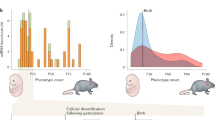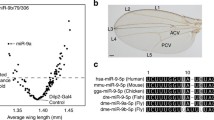Abstract
MicroRNA-8 and its target gene, u-shaped (ush), regulate body size in Drosophila. As the mouse homolog of the Drosophila miR-8, whether the miR-200 family has similar functions and how they perform their regulatory roles in body size control is unknown. In order to discover the biological function of the miR-200s in vivo, we generated mice lacking the miR-200b/200a/429 gene cluster using the Cre/loxp system. miR-200b/200a/429 null mutant mice were viable, fertile, and showed normal development.









Similar content being viewed by others
References
Ambros, V. (2004). The functions of animal microRNAs. Nature, 431, 350–355.
Bartel, D. P. (2004). MicroRNAs: genomics, biogenesis, mechanism, and function. Cell, 116, 281–297.
Bartel, D. P. (2009). MicroRNAs: target recognition and regulatory functions. Cell, 136, 215–233.
Lee, R. C., Feinbaum, R. L., et al. (1993). The C. elegans heterochronic gene lin-4 encodes small RNAs with antisense complementarity to lin-14. Cell, 75(5), 843–854.
Park, S. Y., Lee, J. H., et al. (2009). miR-29 miRNAs activate p53 by targeting p85 alpha and CDC42. Nature Structural & Molecular Biology, 16(1), 23–29.
Choi, I. K., & Hyun, S. (2012). Conserved microRNA miR-8 in fat body regulates innate immune homeostasis in Drosophila. Developmental and Comparative Immunology, 37(1), 50–54.
Hyun, S., Lee, J. H., et al. (2009). Conserved microRNA miR-8/miR-200 and its target USH/FOG2 control growth by regulating PI3K. Cell, 139(6), 1096–1108.
Jin, H., Kim, V. N., et al. (2012). Conserved microRNA miR-8 controls body size in response to steroid signaling in Drosophila. Genes & Development, 26(13), 1427–1432.
Karres, J. S., Hilgers, V., et al. (2007). The conserved microRNA miR-8 tunes atrophin levels to prevent neurodegeneration in Drosophila. Cell, 131(1), 136–145.
He, W., Barak, Y., Hevener, A., et al. (2003). Adipose-specific peroxisome proliferator-activated receptor gamma knockout causes insulin resistance in fat and liver but not in muscle. Proceedings of the National Academy of Sciences of the United States of America, 100(26), 15712–15717.
Nakamura, Y., He, X., Kato, H., Watanapokasin, R., Postlethwait, J. H., et al. (2012). Sox9 is upstream of microRNA-140 in cartilage. Applied Biochemistry and Biotechnology, 166, 64–71.
Rodriguez, A., Vigorito, E., et al. (2007). Requirement of bic/microRNA-155 for normal immune function. Science, 316(5824), 608–611.
Thai, T. H., Calado, D. P., et al. (2007). Regulation of the germinal center response by microRNA-155. Science, 316(5824), 604–608.
van Rooij, E., Sutherland, L. B., et al. (2007). Control of stress-dependent cardiac growth and gene expression by a microRNA. Science, 316(5824), 575–579.
Edgar, B. A. (2006). How flies get their size: genetics meets physiology. Nature Reviews. Genetics, 7, 907–916.
Nijhout, H. F. (2003). The control of body size in insects. Development Biology, 261, 1–9.
Leopold, P., & Perrimon, N. (2007). Drosophila and the genetics of the internal milieu. Nature, 450(7167), 186–188.
Sun, J., Gao, B., et al. (2013). Comparative genomic analysis reveals evolutionary characteristics and patterns of microRNA clusters in vertebrates. Gene, 512(2), 383–391.
Liu, N., et al. (2008). microRNA-133a regulates cardiomyocyte proliferation and suppresses smooth muscle gene expression in the heart. Genes & Development, 22(23), 3242–3254.
Zhao, Y., et al. (2007). Dysregulation of cardiogenesis, cardiac conduction, and cell cycle in mice lacking miRNA-1-2. Cell, 129(2), 303–317.
Baskerville, S., & Bartel, D. P. (2005). Microarray profiling of microRNAs reveals frequent coexpression with neighboring miRNAs and host genes. RNA, 11(3), 241–247.
Acknowledgements
We thank Gaoxiang’s laboratory of the Model Animal Research Center of Nanjing University for their support in generating the loxp-floxed mice.
Author information
Authors and Affiliations
Corresponding author
Ethics declarations
This study was performed in accordance with the Guidelines of Animal Experimentation at the Institutional Animal Care Research Advisory Committee of the Chinese Academy of Agricultural Sciences (CAAS, Beijing, China). All animal experiments were performed in accordance with the regulations of the animal care and use committee of the model animal research center.
Rights and permissions
About this article
Cite this article
Ren, H., Tao, C., Li, K. et al. Generation of a Floxed Allele of the Mouse MicroRNA-200 Clusters. Appl Biochem Biotechnol 182, 1218–1228 (2017). https://doi.org/10.1007/s12010-016-2394-z
Received:
Accepted:
Published:
Issue Date:
DOI: https://doi.org/10.1007/s12010-016-2394-z




